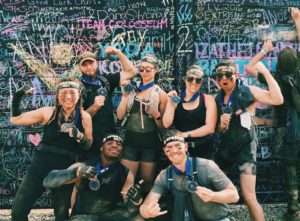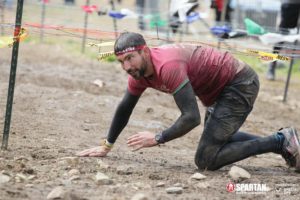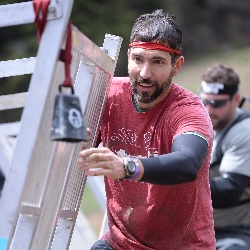How To Train For Your First Spartan Race

So, you are doing it. Maybe you gathered up the courage to sign up on your own or some friends twisted your arm until you finally agreed to it. Either way it doesn’t matter. The result is the same. You are running your first Spartan Race and are probably freaking out about it.
First, I want to give you some assurance. You are not alone. We have all been exactly where you are right now. Terrified of what may happen in that race and trying to find ways to get out of it. But I promise you this. Once you cross that finish line, things are going to be different. You are going to look at yourself differently and you are just scratching the surface on what you can accomplish when you commit to something. You will know at the finish line.
I was no different. I still remember my first Spartan Race in 2013. Honestly the only reason I ran it was because I had a few clients keep asking me about it. I figured if I had clients wanting my advice, I better go through one.
So, my wife and I signed up and I was looking for any reason to get out of it. I didn’t love running, I didn’t want to get muddy, and I had no clue what to expect so it made me nervous. But luckily, I stuck with the plan and ran.
Honestly, I didn’t get it until I finished either. I crossed that finished line and wanted more. I just didn’t want more I had to sign up again. I am pretty sure they put something in that freezing cold water you get in. But whatever it was I started my racing and coaching journey.
During that first race, I got muddy, a little bloody, and did some burpees. I had no clue what to expect and if you told me what I was going to go through beforehand I would have worked even harder to find a way out. You are going to experience it too. The next step is to prep yourself for what you will find.
If you want to get the most out of your experience, you need to prepare.
 While just signing up may be the toughest part of the process, there is still a lot of work that must be done. To sign up and not train or not have a plan is just silly.
While just signing up may be the toughest part of the process, there is still a lot of work that must be done. To sign up and not train or not have a plan is just silly.
While there are many aspects of a Spartan Race that you can train for, this article is just going to get you started and give you an overview of everything you need to consider. When I work with clients, I focus on 4 key areas that you should consider.
Whether this is your first race, or you are training to win the World Championship, you must consider these 4 things in your planning:
- Recovery
- Energy Systems Development
- Strength Training
- Tactical Training
This is the R.E.S.T. system I have used with all my clients and I am going to share some insight into each category to help you out for your first race.
Recovery:
Recovery simply means taking care of your body. You may be excited to start training and getting stronger and faster. These are clearly essential, but in my experience most people train themselves right into a rut. They get hurt or burn out quickly.
So, this isn’t just about a race. This is about living a healthy lifestyle so you body can handle all the abuse you are going to put it through.
After reading this I want you to commit to 3 simple things every day. First, you will get optimum sleep. There are books written about sleep and why it is so critical. Without going into the science for this article you are going to have to take my word for it here. You must make a conscious effort to get better sleep. The magic number depends on you, but it is probably in that 7-10 hour range. If you can wake up feeling refreshed and not need an alarm, you are on the right track. This is one that sounds so simple it can’t work but trust me. Your body does its recovery and repair while you sleep. This is where you see the improvements from your workouts come to life. So, this is nonnegotiable. But the only way to get better sleep is to make a conscious effort to change.
The second is nutrition. Again, we can read hundreds of books on this topic. But let’s keep it simple. The food you eat will become a part of you. Start treating it that way. You aren’t just eating food and calories. You are consuming nutrients that your body will use to function better.
It doesn’t have to be perfect but take steps in the right direction. Find foods that you enjoy and leave you feeling great. If you eat something and feel bloated or run down after, it is your body telling you something. So, eat a diet rich in a variety of fruits and vegetables, high quality protein, and healthy fats.
These foods will help your body generate energy to power through workouts and the race day. Fill your body with junk and you will see how your performance will decrease dramatically. Pay attention to how you feel or perform after certain foods. You will start to notice which are your personal super foods to eat more of.
 The final piece to recovery, is simply listen to your body. You should know the difference between a muscle soreness from a hard workout and pain from over doing it. Once those small nagging injuries show their face, they are hard to get rid of. Trying to push through leads to bigger and bigger problems.
The final piece to recovery, is simply listen to your body. You should know the difference between a muscle soreness from a hard workout and pain from over doing it. Once those small nagging injuries show their face, they are hard to get rid of. Trying to push through leads to bigger and bigger problems.
If injuries pop up, seek a professional immediately to help you get better. In the meantime, you can train in areas that are not painful. There is always something you can do.
Energy Systems Development:
This is a fancy way to simply say, you need your body to be able to create energy long enough for you to finish the race. You may have heard of it called cardio or endurance training. I prefer energy systems development, as we get more advanced, we can focus on training different energy systems.
But right now, you don’t have to worry about that. We are going to focus on time on your feet to make sure you have the endurance to finish the race.
You may be running, walking, or likely a combination of the two. Many people get so caught up in the obstacles that they forget the most common activity you will see in a race is getting your body from the start line to the finish line.
If we focus on the Sprint distance many first timers will take a few hours to complete. So, this will be your training goal. Start with what you can do comfortably. See if you can go for a 30-minute walk or run. If you can go longer, then great. But ease into it. Your goal will be to continuously be on your feet moving for about 2 hours. Don’t worry about intensity here. Just keep moving.
Going back to a previous point about over doing it, try and keep progressions to about 10% per week. This way you can slowly build up that time on your feet without doing too much damage in the process.
Strength:
You can kill yourself over training on obstacles, but if you simply aren’t strong enough it doesn’t matter how much you practice. Strength is what we use to build the base for our obstacle training.
The strength you want to focus on is functional training. Unfortunately, when you look at the layout of most gyms you see the floor covered with machines. While these have their place, it is not with training for a Spartan.
You goal is to become brilliant at the basics. Try building up your squat, lunge, deadlift, push up, pull ups, and core stability. If this is all you did each workout you will be on the right track. Forget about body building programs where you focus on building a muscle group each day. This has no place in the training you will be starting.
If you aren’t familiar with these exercises, I highly recommend finding a coach that can work with you to learn the essentials.
Tactical:
 Our final piece is the obstacle specific training. I leave this for last, because it needs to be the last thing you focus on. If you don’t take care of yourself, improve endurance, and get strong, you will have minimal success on the obstacles.
Our final piece is the obstacle specific training. I leave this for last, because it needs to be the last thing you focus on. If you don’t take care of yourself, improve endurance, and get strong, you will have minimal success on the obstacles.
This piece also gets to be a challenge because you most likely don’t have access to obstacles. You still can improve on some basic items that will directly carry over to what you see in the race.
Four places to start your obstacle specific training are with hanging, carrying, crawling, and climbing.
Hanging is just like it sounds. Find a bar and hang from it. There are quite a few obstacles you will see where you need to support your own weight. So, get really good at it. See if you can build up to 60 seconds of continuous hanging.
Carrying is another simple thing we can train and will see in the race. Carry objects whenever you can. You can use dumbbells, kettlebells, buckets, small children, etc. The heavier you can go and the more awkward it is to hold the better. In the race you will carry things in different positions for a few minutes at a time so build up to a couple minutes of continuous carrying.
Crawling exercises can be useful for a variety of reasons and directly help our last area of climbing. Get down on all fours and crawl like a baby. At first it will be uncomfortable and challenging, but that is what this is all about. Then you can lift your knees up and start bear crawling. Once you master that you can go forwards, backwards, and side to side.
Our final area of training is climbing. This one gets to be a bit trickier since it works best when you have a wall to work on. As mentioned, crawling will help improve strength and hip mobility so you can get over walls a bit easier. You may have to be creative here and find small walls you can start working on. Even if you don’t jump over, you can work on getting to the top and then going back down.
I know you have a lot to think about know. My goal was not to overwhelm you, but hopefully help you layout a simple blue print to get you started on your plan.
And when you need help all you have to do is ask. The great thing about the Spartan Community is that there are thousands of supporters out there. You just have to make an effort to find them.
If you need help getting started make sure you sign up for my free 2 week OCR Jump Start Training plan to see how the R.E.S.T. system works for you.

